Published
on 14
Mar 2010
|
All rights reserved.
|
|
|
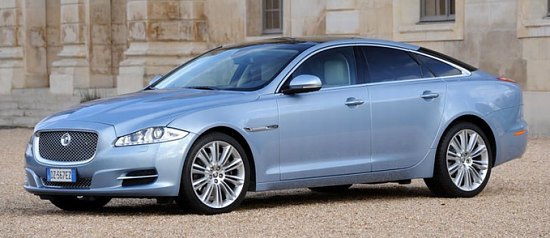 |
|
Think
about how a big cat looks - slim, light and athletic on the one hand,
calm and noble on the other hand.
|
|
I
have a soft spot on Jaguar XJ since childhood. Many years ago a British
guy ran a classic car garage near my house. Everyday on my way to
school I walked pass the garage in front of which a Jaguar XJ6 Series
III was parked. Of course, at that time I had no knowledge about
the
history or fame behind this car, neither had I heard the name
William Lyons or Pininfarina. However, that did not stop me from
admiring the classical shape of the XJ. Since then
the Jaguar saloon had a special place in my heart.
History told us the original XJ was the most enduring saloon design of
all time. From its birth in 1968 to the last generation ended in 2009,
its style barely changed a little. Even though the underpinnings were
thoroughly modernised from time to time - with major redesign in 1986, 1993, 1997
and 2003
- its appearance still sticked to the original
design by Sir Lyons. However, this situation cannot carry on forever.
As reflected by sliding sales in recent years, new generations of
customers are not in fond of classical styling. Many of them went to
the Avant-garde camp of BMW and Audi (now also Lexus). Moreover, the
classical approach is difficult to work with modern
aerodynamics. Further tweaks may damage the integrity of the original
design. That is why Ian Callum, Jaguar's design boss, decided to
reinvent the design language of XJ. Compared with his predecessor, the
late Geoff Lawson, Callum
is more willing to take risks and more eager to make a statement of his
own. This sounds worrying to traditionalists and the hardcore fans of
Lyons (like me). However, perhaps we should
think in the other way: if William Lyons were still alive, would he do
the
same ? or would he choose to play safe ? Remembering his approval of
the
forward-thinking E-type, I think he would most probably agree with
Callum.
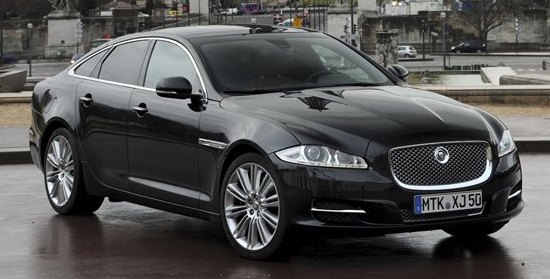 |
|
Ian
Callum is eager to make a statement of his own...
|
|
Having experimented with XK coupe in
2006, Callum hit the jackpot with the new XF launched next year. The
latter is a landmark design, combining the sportiness of coupe and the
elegance of luxury car in a way no one else has succeeded - not even
Mercedes-Benz CLS. Now the new XJ develops further in this direction.
Given a more generous length than the XF, the flagship Jaguar can only
look better.
So what is the outcome ? Let me save a thousand words and summarize in
this way: think about how a real jaguar (I mean the big-cat-style
animal) looks - slim, light and athletic on the one hand, calm and
noble on the other hand. You can see the same character in the new XJ.
In my eyes, this is the best ever interpretation of "four-door coupe",
and way more attractive than the conservative Mercedes, BMW and Audi
etc. Drive it in urban area and you will find everybody staring at it.
It is easily the most head-turning luxury car on the market. The only
controversial point is the black-out C-pillars, introduced to lighten
the visual mass of the back. It takes some getting used to, but it does
make the XJ even more special, thus becomes a signature of the car.
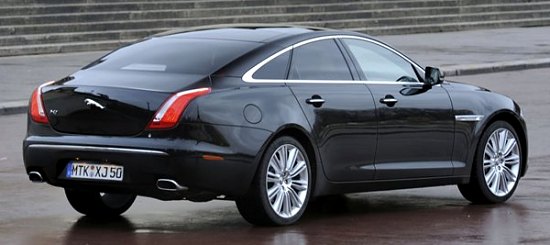 |
|
Black-out
C-pillars are its signatures.
|
|
Incredibly, under the sheet aluminum
is the same platform as the last generation XJ. Jaguar spent
substantial money to develop the outgoing car's aluminum monocoque
chassis, so it has to recoup the investment from the new generation.
Since the underpinnings are fundamentally the same, the 3034 mm
wheelbase is unaltered. Its overall length has grown by merely 30 mm.
Its width has grown by another 30 mm to house wider tracks. The 1448 mm
height is identical to the old car's, making it lower than its
mainstream luxury car rivals but taller than the sporty Porsche
Panamera and Maserati Quattroporte. As expected, the sleeker shape
returns lower drag. Cx is lowered from the previous 0.32 to a much more
competitive 0.28.
As before, Jaguar XJ and Audi A8 are the only mass production cars in
the world that use aluminum chassis. They are more costly to build than
conventional steel monocoque, of course, but the price pays off on the
scale. Take an XJ 5.0 V8 for example, it tips the scale at 1755
kilograms with full tank of fuel and fluid, undercutting BMW 750i by
190 kg, Mercedes S500 by 125 kg and Maserati Quattroporte by 235 kg.
Without burdening by 4-wheel-drive hardware, it also beats the new Audi
A8 by 80 kg. In fact, the XJ is even lighter than the steel-bodied XF !
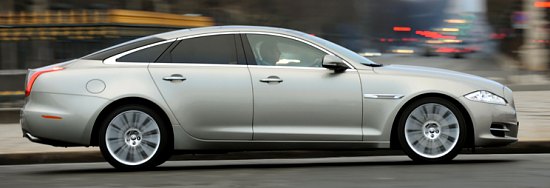 |
|
Incredibly,
under the sheet aluminum is the same platform as the last generation
XJ.
|
|
As before, the lightweight chassis of
Jaguar is made of stamped, extruded and cast aluminum parts bonded by
rivets and epoxy, like Lotus Elise but unlike Audi A8 (which uses
mainly welding). However, plenty of fine tunings improved the new
chassis:
1.
|
By using more high-strength aluminum and
more cast nodes, its torsional rigidity is lifted by 11 percent. |
2.
|
In
order to improve turn-in response and steering precision, the front
subframe is no longer mounted to the chassis via rubber bushings, but
rigidly connected. |
3.
|
The hydraulic-assisted steering rack comes
straight from XFR. It is quicker and more accurate than the old helm. |
4.
|
While
the old car employed air springs front and rear, the new car reverts to
steel springs up front in order to deliver keener response and feedback
to the driver. Air springs still serve the rear suspension, as back
seat
passengers need that extra cushioning and the ability to maintain ride
height regardless of load. |
5.
|
The
previous CATS adaptive damping was a two-stage system that switched
between hard and soft setting. Now the new car follows XF and XK to
adopt a continuously variable damping by Bilstein. |
6.
|
The
philosophy of suspension tuning has also been changed. Previous Jaguars
always biased strongly towards supple ride. Now Gaydon prefers a
sportier character like German cars, which means stiffer springs to
tighten body control and a damping tuned to match the sporty character. |
7.
|
Finally, an electronic active rear
differential is added to the range-topping Supersport model, utilizing
torque vectoring to eliminate under and oversteer.
|
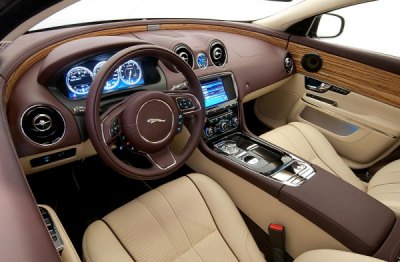
|
|
You
feel like sitting in a luxury yacht...
|
|
But
before assessing its dynamic behaviour, let's get on board first. Open
the door, wow, what you see is the most visually attractive cabin in
the mainstream luxury segment ! It looks really special, like nothing
else in the class thanks to its unusually sporty and bespoke feel. It
makes the cabin design of BMW, Mercedes and even Audi dull in
comparison. The German cars employ top-notch materials, unquestionably,
but none of them mix and match leather and wood as tastefully as the
British car. First of all, you will notice the dashboard level is set
much lower than those in conventional sedans, more like that of a
sports car, especially with the presence of a big transmission tunnel.
The dashboard architecture recesses from the shoulder line by a couple
of inches. Brilliantly, Ian Callum filled that gap with an arc of
wooden stripe, which flows to an ocean of wood at each door. As a
result, you feel like sitting in a luxury yacht !
The dashboard architecture is as simple and intuitive as those of
traditional sports cars, but it is elegantly decorated with lacquer
black (on center console) and a lot of chrome. Callum chose classic
eyeball air vents to enhance the sports car feel further. They are
nicely chromed and has a tactile feel in swivel. The small-diameter
helm looks sporty and feels great in hands. Regarding fancy technology,
how can we miss the XF-style rotary gear selector, which rises from the
transmission tunnel when you wake up the XJ ? New toys include a
virtual instrument panel by TFT screen, which also changes colors
depending on driving mode, and a center console touch screen that
displays something (e.g. sat-nav map) to the driver and something else
(e.g. DVD movie) to the passenger at the same time, though both
features were already available in Mercedes S-class. On the downside,
the Jag does not offer a lot of advanced safety equipments like its
rivals. Things like night vision, lane departure warning, blindspot
warning or drowsy alert are all missing.
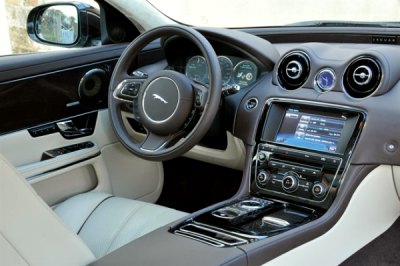 |
|
Eyeball
air vents are chosen to enhance sports car feel.
|
|
Fortunately, interior space is
adequate, although its coupe shape suggested otherwise. It is not as
spacious as Mercedes S-class, of course, but it is not ashamed to
compare with A8 or 7-series, at least in the popular long-wheelbase car
(which adds 125mm). An XJ LWB offers vast of legroom and enough
headroom to accommodate passengers up to 6 feet 4 inch. In
short-wheelbase form, rear headroom is a little in short supply.
However, either cars treat its driver well with loads of head and
legroom, comfy seats and an ambience lightened by the glass moonroof.
This is perhaps the most important to the driver-oriented Jaguar.
Limited by its small economy of scale, Jaguar can offer only three
choices of powertrain - 275 hp 3.0 twin-turbo diesel V6, 385 hp 5.0 V8
and 510 hp supercharged 5.0 V8 (remark: some markets are offered with
470 hp version of the last engine) - all come straight from XF together
with the compulsory ZF 6-speed automatic. Fortunately, all of them are
excellent engines. In Europe, majority of sales will go to the diesel
V6, which is immensely torquey (442 pound-foot), quick (0-60 mph in 6
seconds flat), frugal (40 mpg combined) and remarkably refined. It is
the most sensible choice in the bunch. Globally, the naturally
aspirated V8 is expected to take 60 percent shares of the total sales
because clean diesel is not available in America. It is also a good
engine, being the smoothest and quietest in the range. Though not as
quick as the turbocharged BMW 750i, its 0-60 mph time of 5.4 seconds is
by no means slow, and definitely feels faster than Audi A8 4.2 FSI
which claimed the same time. It's not a surprise, because the Jaguar V8
is not only larger in capacity but also packs virtually any
technologies available, from direct injection to variable valve timing
and lift. The Jaguar's 6-speed ZF box might be a generation older than
Audi's 8-speed unit, but in terms of response and smoothness it lost
nothing.
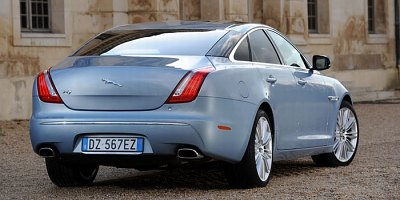 |
|
While
previous XJs were magic carpets, the new car feels far more connected
to the road...
|
|
The supercharged V8 of range-topping
XJ Supersport is carried over from XFR. As both cars weigh the same,
you can expect the same performance - we are talking about 0-60 mph in
4.7 seconds and 0-100 mph in about 10 seconds. Jaguar could have named
it as XJR, but a change in marketing strategy means the flagship large
car will no longer be promoted as a fire-breathing performance saloon.
That task will be left to the smaller XFR. The XJ Supersport is more
about strong performance at minimum fuss. Its extra sound insulation
(see that plastic engine cladding) effectively filters out most of the
supercharger whine, although you can still hear pronounced exhaust note
once you hammer the throttle.
On the road, if you had driven the old XJ, you will be impressed by the
new car's effortless performance as well as its quiet cabin. Not so
sure is the ride quality. While previous generations of XJ were
renowned for a magic carpet ride over poor surfaces, the new car with
its stiffer suspension setting and lower profile tires feels far more
connected to the road. On broken surfaces, it is not as comfortable to
back seat passengers. Some may feel disappointed, but in return the car
provides you unprecedented level of control. Each encounter of bumps
gets responded immediately and cleanly without following by bounces. As
a result, on normal roads the ride is actually more composed. If you go
cross country, the new XJ will be the more comfortable companion.
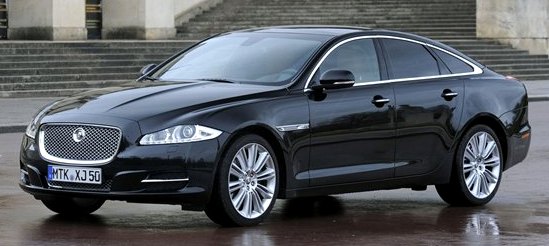 |
|
The
Jag feels old-school honest, and it delivers handling and ride in one
consistent manner...
|
|
However, what makes the XJ special is
its handling. This car
feels really agile and light on its feet. It delivers much the same
cornering prowess as a 7-series or A8 without resorting to active
anti-roll bars, active steering, 4WD or 4WS. The only fancy electronic
driving aid it provides is a simple control system with the choice of
comfort, dynamic or snow mode, which alter damping stiffness, gearshift
speed and throttle response. That's all. The Jaguar utilizes its
inherent advantage in weight and balance to tear its rivals in pieces.
Therefore, its driving feels natural and engaging. While the German
cars feel like a summation of different systems and their handling/ride
characteristics depend very much on the settings you choose, the Jaguar
feels old-school honest, and it delivers handling and ride in one
consistent manner. With a light yet accurate and uncorrupted steering,
a neutral cornering attitude, excellent body control, progressive
braking and deeply contoured driver seat, the XJ is the most enjoyable
big limousine to attack winding roads. In this way, it sounds closer to
the camp of Maserati Quattroporte and Aston Rapide.
Because the new XJ is this good to drive, this good to look and this
good to sit in, we have no reason not to declare it as the new class
leader. Although Mercedes S-class is still the better car to back seat
passengers, to those who drive by themselves, nothing else is as great
as the XJ. |
Verdict:      |
| Published
on 4
Oct
2012 |
All rights reserved.
|
|
XJ 3.0V6 SC
|
|
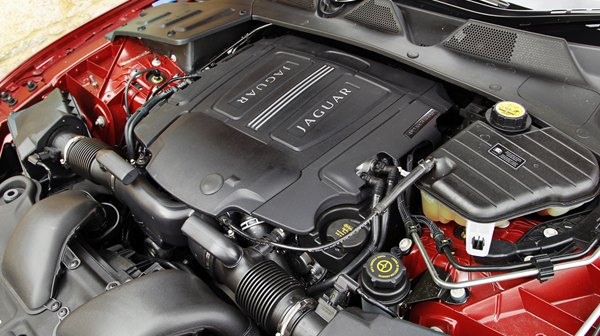 |
|
New
supercharged V6 fills the gap between V8 and V6 diesel, but it is not
the best choice...
|
|
Since the demise of the
Ford Duratec 3.0 V6, Jaguar has been missing a petrol V6 for some time.
The current XF and XJ are powered by either 3-liter turbo diesel V6 or
5-liter V8 (supercharged or not). This mean for diesel-unfriendly
markets like the USA, China and Russia these cars are being sold
without a relatively affordable and frugal engine. The introduction of
new V6 should fill this missing link.
The new V6 is derived from the existing Gen III AJ-V8. Apart from
getting rid of two cylinders, its bore and stroke have been reduced to
84.5 and 89 mm respectively, dropping capacity to 2995 cc. As it shares
the V8's all-aluminum construction and 90-degree V-angle, it
necessitates counter-rotating balancer weights to be added at both ends
of the crankshaft to cancel the first order vibration. Dual-VVT and
direct injection are carried over from the V8 as well, but compression
ratio has been lifted from 9.5:1 on the supercharged V8 to 10.5:1.
Inside the V-valley sits an Eaton TVS twin-vortex supercharger.
XJ is the first model to get the service of this new engine. In this
guise it produces 340 horsepower and 332 pound-foot of torque, more
than its Audi and BMW rivals. However, that cannot match the naturally
aspirated V8's 385 hp and 390 lbft, even though it might have a flatter
torque curve, which stays flat from 1800 to 4000 rpm. Official figures
said the 3.0 SC goes from rest to 60 mph in 5.7 seconds, a couple of
tenths longer than the 5.0 V8. Meanwhile, CO2
emission is reduced by 15 percent to 224 g/km, partly thanks to the
inclusion of automatic stop-start and the upgrade to ZF 8-speed
automatic gearbox.
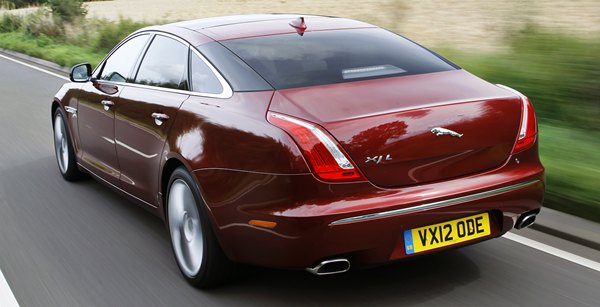 |
|
Expansion
joints on motorway are better dealt with than before, but still you
won't buy this car for rolling refinement.
|
|
On the road, the downsized engine feels plenty strong and flexible.
Refinement is generally excellent, although at high rev it does not
deliver the same turbine smoothness as the V8. The supercharged sound
is by no means unpleasant, while the exhaust note is well tuned. Even
so, you won't find it as musical as the naturally-aspirated V8. The
8-speed gearbox works flawlessly most of the time, but it could be slow
to downshift when you floor down the throttle suddenly from cruising
speed.
The rest of the car is not much different from our first review. Even
though Jaguar has taken this opportunity to soften its suspension a
little, the big cat is still easily the hardest riding big limousine on
the market – save Maserati Quattroporte Sport GTS perhaps. It still
crashes over low-speed bumps and broken pavements. At speed, expansion
joints on motorway are better dealt with than before, but still you
won't buy this car for rolling refinement. On the flip side, it is
still the sportiest to handle and the most enjoyable to drive hard.
Great body control, keen response and communicative steering mark it
out from the usual German luxury limousines. This is why it still
catches our hearts.
Having said that, the 3.0 supercharged V6 is probably not a leap as big
as we hoped for. Considering its emission and fuel consumption are only
10 percent lower than those of the 5-liter naturally aspirated V8 (now
also pairs with 8-speed auto), its compromises in sound quality and
high-end refinement are not so easy to justify. To purists, the V8 is
still the better choice.
|
Verdict:     |
Published
on 13
Aug 2013
|
All rights reserved.
|
|
XJR
|
|
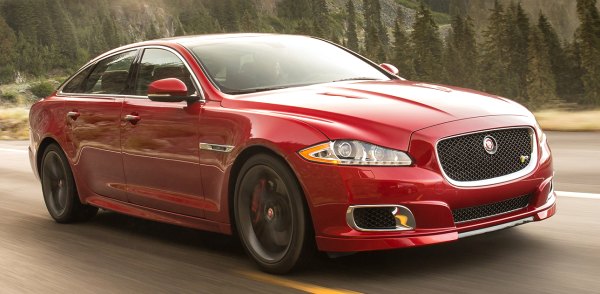 |
|
The
XJR should have been called XJR-S instead, considering how sporty the
XJ Supersport is.
|
|
The rebirth of XJR, the
introduction of XKR-S, XFR-S and F-Type are signs that Jaguar is
adjusting its product strategy. In the attempt to distinguish itself
from the established German rivals, it is edging closer to the
forefront of sporty motoring. You might argue that XJR is not exactly a
new addition. Jaguar produced 3 generations of XJR before the birth of
the current generation XJ, and each of them represented a giant leap in
performance from the lesser XJ models. However, the new XJR is on a
different level again. Considering the existing XJ Supersport is
already a very sporty limousine – for example, its supercharged 5-liter
V8 produces 510 horsepower, some 110 hp more than the last XJR! – it
could be easily branded as XJR if Jaguar wished. With even more power
and sportier suspension, the new XJR should have been called XJR-S
instead, especially when you know it employs the same engine tuning as
XKR-S and XFR-S.
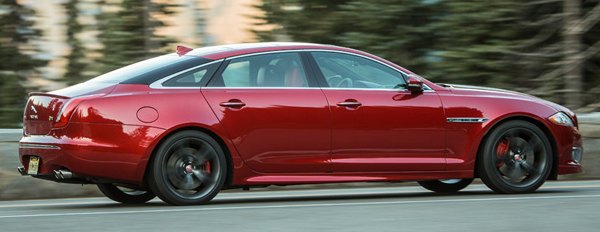 |
|
The
exhaust note is too civlized and no where as special as that of AMG or
Maserati.
|
|
The XJR engine is practically unchanged from the Supersport, but its
revised ECU and new exhaust liberate another 40 horsepower and 41 lbft
of torque at the top end. By percentage it is not a big jump, but
anyway the extra performance can be felt on the road, as is the 0-60
mph time of 4.4 seconds. Top speed is now governed at 174 mph instead
of the usual 155 mph. Although its performance is still no match with
that of Mercedes S63 AMG or Porsche Panamera Turbo S, the gap is so
small in the real-world that I suppose the only thing leaving something
to be desired is the exhaust note, which is too civlized and no where
as special as that of AMG or Maserati.
More important is how it corners. The XJR has beefed up suspension,
which is 10 percent stiffer than the Supersport, thanks to harder
springs and revised adaptive damping program. The hydraulic power
steering is recalibrated to be heavier and 10 percent faster around the
straight-ahead. The Pirelli rubbers are not only wider, with 265/35ZR20
up front and 295/30ZR20 at the rear, but also specially developed for
the car. The active differential and stability control are also
recalibrated to reflect its higher cornering prowess. Lastly, larger
disc brakes (380 mm front and 376 mm rear) provide enhanced stopping
power.
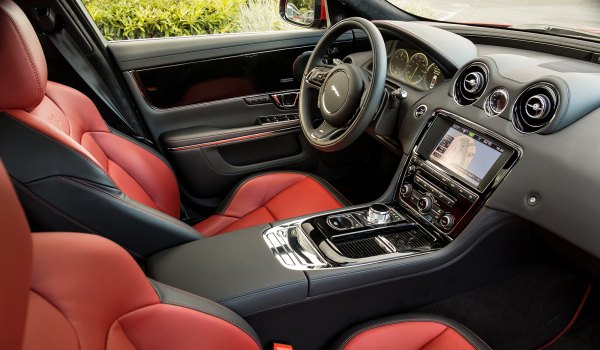 |
|
A
worthy choice to keen drivers who also want the comfort and image of
big limos.
|
|
Inside, the only change is the sporty bucket seats. No complaint here,
as the XJ already has one of the most stylish cabins, it would be
foolish to use gadgets like carbon-fiber trims to ruin its purity.
Outside, the car can be distinguished with the bezels at the front side
intakes and quad-exhaust at the back. Like other performance
limousines, it is deliberately understated to please its buyers.
On the road, as expected, the XJR is a little sharper to drive than the
XJ Supersport. It grips better, corners flatter and steers sharper. The
difference is not as dramatic as, say, a Mercedes S-class transformed
to S63 AMG, because the XJ Supersport (or actually all XJs) is already
a very good driver's car in the limousine crowd. It feels light and
agile, willing to turn and has its large body controlled precisely. The
R treatment just lifts the game by 10 percent here and there. On the
downside, the ride quality suffers a bit on poor surfaces, which means
it suits the smooth roads of USA and European continent more than
Britain. Anyway, the compromise is well judged for a sport limousine.
The bottom line is: XJR is a worthy choice to keen drivers who also
want the comfort and image of big limos.
|
Verdict:     |
Published
on 26
Oct 2017
|
All rights reserved.
|
|
XJR 575
|
|
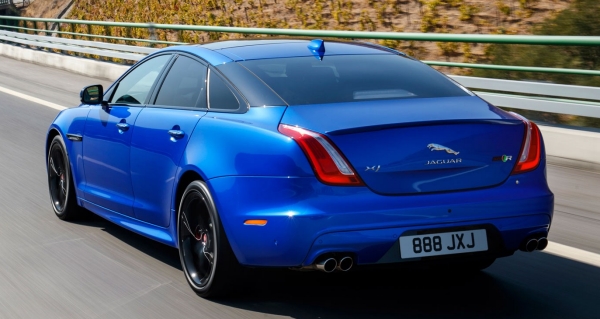
|
|
The
improvements might be subtle, but the XJR's great fundamental still
shines.
|
|
First impression on the XJR
575 is not good: the eye-catching blue paint suits more a Ford Focus RS
than a Jaguar luxury performance flagship. The same goes for the black
instead of chrome inserts in its front grille and bumper intakes.
Inside, the “575” decals on seats pleases boy racers instead of the
wealthy and matured buyers Jaguar aimed at. The design is not quite as
tasteful as we expected from Jaguar or Ian Callum. This proves that
even a great designer may have off-form days.
In essence, the XJR 575 is only a subtle evolution of the outgoing XJR
– yes, the 550hp model is no longer available. And don’t forget that
the current generation XJ has been soldiering since early 2010. The
next generation XJ is likely to become an all-electric limousine, but
it is at least 3 years away from reality. Meanwhile, sales of the
current generation dropped to just 11,500 units in the last fiscal year
as Mercedes S-class and BMW 7-Series dominate. This year the F-segment
is going to be tougher still because of the renewal of Audi A8 and
Lexus LS.
With limited sales volume in sight, Jaguar has no option but a subtle
refresh. All XJ models now get the company’s electric power steering
finally, which is a must to enable the car to equip automatic driving
aids like parking assist and lane-keeping assist. It also gets an
updated infotainment system, which is a big improvement from the old
unit but still no match for its German counterparts. On the XJR 575,
the interior adds carbon-fiber trims (quite pointless to me but buyers
love anyway) and diamond stitching on the seats. However, what makes
the XJ outstanding is still its low-setting, cocooned dashboard
architecture. Even though the quality of materials, build and
switchgears is no longer as good as those of the German, it feels more
special. And its sports car-like low driving position is unmatched by
anything in the class without a Porsche badge.
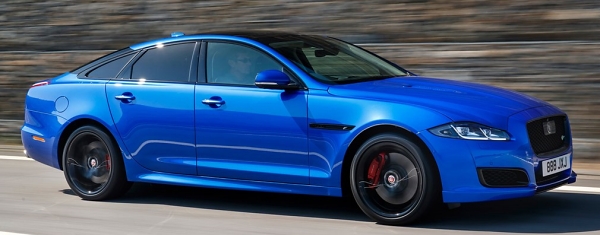
|
|
For
pure driving excitement, it beats even the big Porsche.
|
|
As suggested by its name, the 5-liter supercharged V8 gets a power
boost of 25 ponies thanks to a remapped ECU. Peak torque inches up by
merely 14 lbft, and it is seen at a narrower window, so in the real
world it is hard to say if the XJR 575 is faster – unless you push it
on Autobahn beyond 174mph, because its speed regulation has been lifted
to 186mph, or the magic 300kph mark. 0-60 mph is supposed to take
two-tenths less at 4.2 seconds, but hey, the new Mercedes S63 4matic
takes 3.4 seconds while BMW M760Li needs 3.6 ticks!
Yes, the Jaguar cannot win over its German rivals in straight line
speed. However, it is also the lightest and lowest car in the class.
Coupling to Jaguar’s great chassis tuning and a suspension setting
biased towards the sporty side, no wonder it feels the sportiest to
drive this side of Porsche Panamera. It feels lighter, nimbler and
tighter controlled than either S63 or BMW M760Li even though without
the aid of rear-wheel steering. As in the case of XE and XF, its
electrical power steering is direct, precise and nicely loaded with the
information you need, or in other words, peerless. The engine might not
be as crazy as AMG’s V8 or as smooth as BMW’s V12, but it is still a
faithful powerplant with linear power delivery, crisped throttle
response and a nice, albeit muffled snarl at work. The automatic
gearbox shifts impeccably and responds quickly to manual shift. The
brakes are also very good and trustable. For pure driving excitement,
it beats even the big Porsche.
When you want to relax, the Jaguar is not quite as good as the German.
Even in comfort mode the suspension still rides firmer than others,
although it is more than acceptable. At higher speeds there is more
wind noise penetrated from the pillars. That said, there is no point to
pursue maximum refinement if you buy a performance flagship like this.
What make you hesitant are likely to be its older packaging,
electronics, build quality and the questionable cosmetics. As a
7-year-old model, yes, it does feel outdated in many aspects. But if
you focus on dynamics, it can still teach the German cars a lesson or
two.
|
Verdict:     |
|